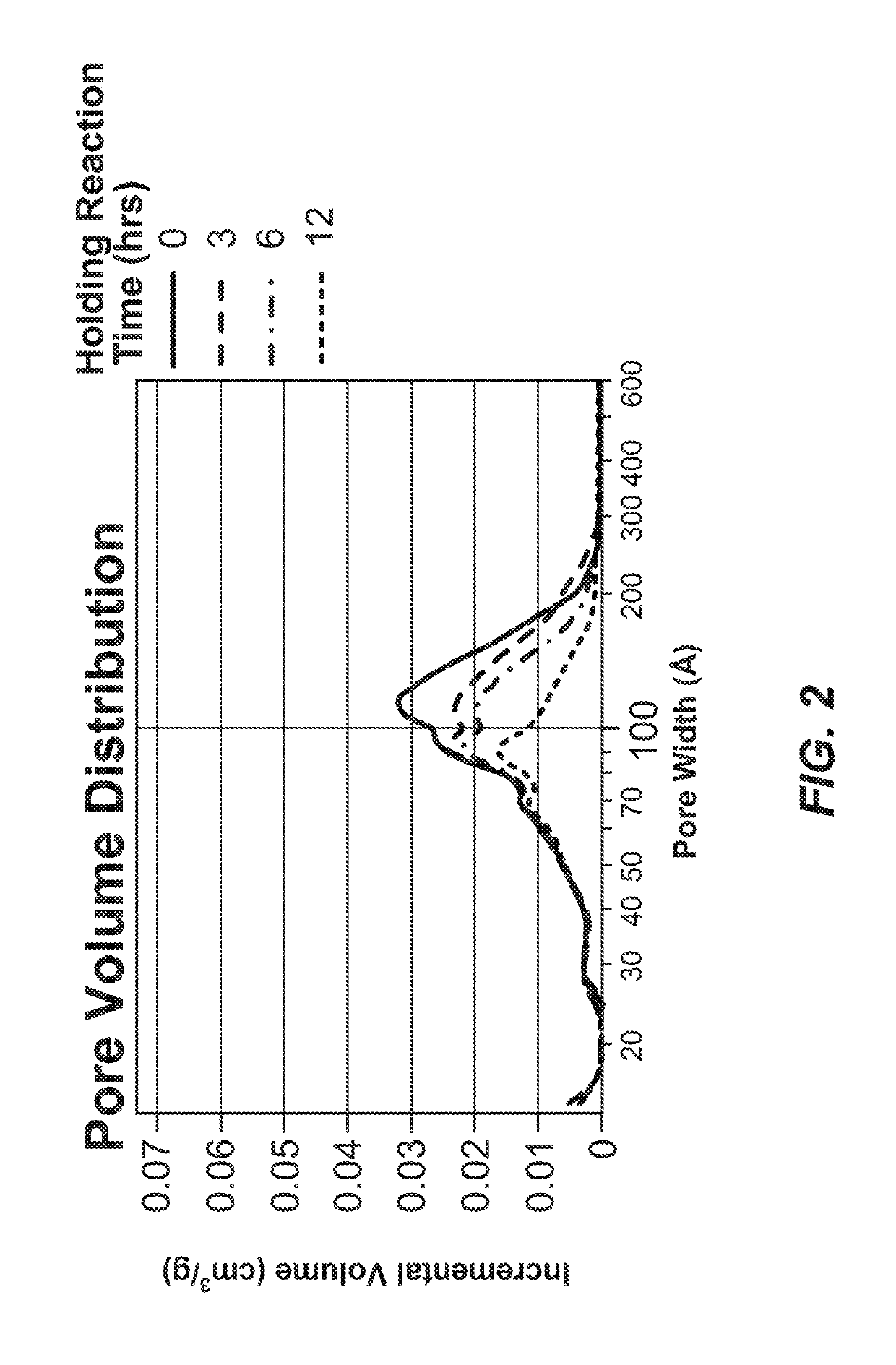Methods for preparing carbon materials
- Summary
- Abstract
- Description
- Claims
- Application Information
AI Technical Summary
Benefits of technology
Problems solved by technology
Method used
Image
Examples
example 1
Preparation of Carbon Material
[0494]Exemplary carbon material was synthesized using a polymer prepared from resorcinol and formaldehyde in a water / acetic acid solvent in the presence of ammonium acetate catalyst. The reagents were added to the reaction mixture in the amounts indicated in Table 1 below.
TABLE 1Reagents used to prepare exemplary carbon materialReagentAmount (wt. %)water23.8%resorcinol30.3%ammonium acetate0.28%-0.42%acetic acid 5.5%formaldehyde (37 wt. % in water)40.1%
[0495]Water, acetic acid (glacial), resorcinol and ammonium acetate were mixed in a kettle reactor and heated to 30° C. To the resultant mixture, the formaldehyde solution was added. The temperature of the resulting reaction mixture was maintained at between 39-50° C. for 0 to 6 hours. The reaction mixture was then cooled to 20-30° C. and transferred to 250 mL-1 L polypropylene bottles via decantation.
[0496]The refractive index (RI) of the reaction mixture was measured following the transfer and ranged fro...
example 2
Mesopore Volume Variability of Carbon Material as a Function of Hold Time—Trial 1
[0502]Four sample preparations of exemplary carbon materials were synthesized according to the procedure described in Example 1 and the following parameters. The reagents were added in the amounts indicated in Table 6, below.
TABLE 6Reagents used to prepare exemplary carbon material samplesReagentAmount (wt. %)water 4.5%resorcinol 30%ammonium acetate0.26%acetic acid 5.4%formaldehyde59.9%(25 wt. % in water, 0.5% methanol)
[0503]All reagents except formaldehyde were combined and heated to 40° C. The formaldehyde solution was pumped into the reactor over 145 minutes while maintaining a temperature between 39-40° C. The resultant reaction mixtures were cooled to 22° C. before decanting. The 4 sample preparations were held between 20° C. and 25° C. for 0, 3, 6, and 12 hours.
[0504]Following the variable hold time, samples were cured in an oven set to an initial temperature of 25° C. followed by a ramp to 95° C....
example 3
Mesopore Volume Variability of Carbon Material as a Function of Hold Time—Trial 2
[0507]Four sample preparations of exemplary carbon materials were synthesized according to the procedure described in Examples 1 and 2 and the following parameters. The reagents were added in the amounts indicated in Table 8, below.
TABLE 8Reagents used to prepare exemplary carbon material samplesReagentAmount (wt. %)water24.0%resorcinol30.2%ammonium acetate0.26%acetic acid5.5%formaldehyde40.0%(37 wt. % in water, 15% methanol)
[0508]All reagents except formaldehyde were combined and heated to 50° C. The formaldehyde solution was pumped into the reactor over 145 minutes while maintaining a temperature between 49-50° C. The resultant reaction mixtures were cooled to 25° C. before decanting. The 4 sample preparations were held between 20° C. and 25° C. for 0, 1.7, 3, and 5 days.
[0509]Following the variable hold time, samples were cured in an oven set to 90° C. and held for 48 hours. The samples were then coo...
PUM
| Property | Measurement | Unit |
|---|---|---|
| Temperature | aaaaa | aaaaa |
| Temperature | aaaaa | aaaaa |
| Temperature | aaaaa | aaaaa |
Abstract
Description
Claims
Application Information
 Login to View More
Login to View More - R&D
- Intellectual Property
- Life Sciences
- Materials
- Tech Scout
- Unparalleled Data Quality
- Higher Quality Content
- 60% Fewer Hallucinations
Browse by: Latest US Patents, China's latest patents, Technical Efficacy Thesaurus, Application Domain, Technology Topic, Popular Technical Reports.
© 2025 PatSnap. All rights reserved.Legal|Privacy policy|Modern Slavery Act Transparency Statement|Sitemap|About US| Contact US: help@patsnap.com



